Updated: January 31, 2025
Written by Adam Graham
Adam Graham is a construction industry analyst at Fixr.com. He has experience writing about home construction, interior design, and real estate. He communicates with experts and journalists to make sure we provide the most up-to-date and fact-checked information. He has been featured in publications such as Better Homes and Gardens, and written for various outlets including the National Association of Realtors, and Insurance News Net Magazine.
Learn moreReviewed by Adam Graham
Gutters can be found in various materials, from vinyl to aluminum, and galvanized steel is one of the strongest and most durable. Highly resistant to dents, corrosion, and the elements, it is a great choice for those wanting strong, long-lasting gutters. However, it comes at a price, often being more expensive than many other materials.
The national average cost for installing galvanized steel gutters is between $900 and $1,350, with most people paying $1,472 for 150 linear feet of seamed galvanized steel gutters installed. This project’s low cost is $751 for 80 linear feet of galvanized steel seamed gutters installed. The high cost is $1,926 for 200 linear feet of galvanized steel seamed gutters installed.
Galvanized Steel Gutters Cost
| Galvanized Steel Gutter Installation Cost | |
| National average cost | $1,472 |
| Average range | $900-$1,350 |
| Low-end | $751 |
| High-end | $1,926 |
Galvanized Steel Gutters Cost per Linear Foot
Galvanized steel gutters, like all rain gutters, are sold and installed by the linear foot. This is the length of the gutters needed for the project in feet. The total cost for galvanized steel gutters per linear foot is $4 to $13 for the material or $5 to $20 installed. Galvanized gutters can be found in seamed and seamless installations and come in several styles, widths, and colors, influencing the project cost. Most homes need around 150 linear feet of gutters, but this can vary based on the home size and roof slope. Below are the average costs to install galvanized steel gutters based on the project size.

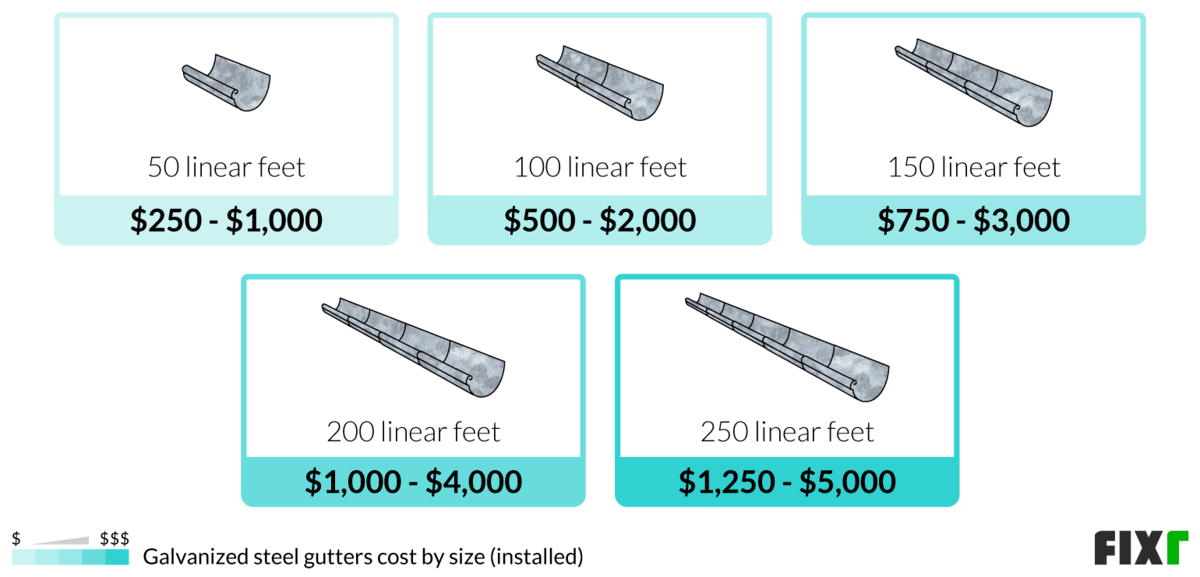
| Size | Average Costs (Installed) |
| 50 Linear Feet | $250 - $1,000 |
| 100 Linear Feet | $500 - $2,000 |
| 150 Linear Feet | $750 - $3,000 |
| 200 Linear Feet | $1,000 - $4,000 |
| 250 Linear Feet | $1,250 - $5,000 |
Galvanized Gutters Price by House Size
Your home size can impact the total amount of gutters needed. While your roof shape and pitch can influence how much guttering you need, the larger your home, the more gutters you need. House interior square footage does not always match the roof size or gutter requirements. You may need a range of gutter lengths, depending on the location, roof shape, and exterior wall length. Below are the average costs to install galvanized steel gutters on homes of various sizes, using the most common gutter lengths for each.

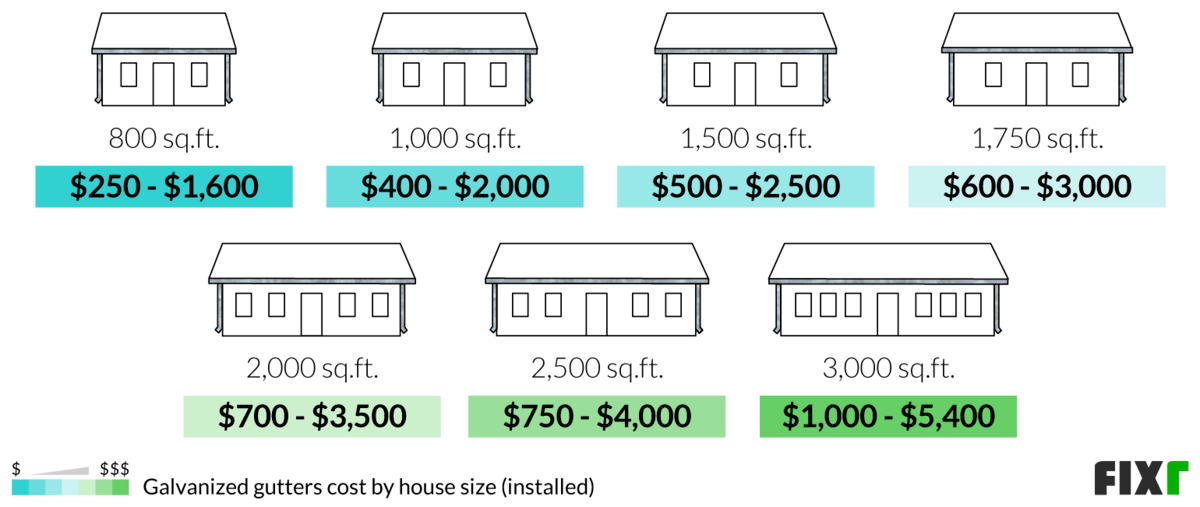
| House Size | Average Cost (Installed) |
| 800 sq.ft. | $250 - $1,600 |
| 1,000 sq.ft. | $400 - $2,000 |
| 1,500 sq.ft. | $500 - $2,500 |
| 1,750 sq.ft. | $600 - $3,000 |
| 2,000 sq.ft. | $700 - $3,500 |
| 2,500 sq.ft. | $750 - $4,000 |
| 3,000 sq.ft. | $1,000 - $5,400 |
Galvanized Steel Gutters Cost by Number of Stories
The number of stories your home has can impact the cost of your gutter project. Taller homes need longer downspouts, increasing the project’s material costs. Taller homes may also be more difficult to install the gutters, depending on the architecture’s height and complexity. Your home’s height may impact the home size. While a 1-story home with 2,000 sq.ft. may need more gutters than a 2-story home with 2,000 sq.ft., larger homes tend to have more stories than smaller homes. However, there is often overlap in the gutter amount needed.
Below are the average costs to install galvanized steel gutters on homes of 1, 2, and 3 stories, assuming a 1-story home is between 800 and 1,500 sq.ft, a 2-story home ranges from 1,500 and 2,500 sq.ft., and a 3-story home is between 2,000 and 3,000 sq.ft. Your home may fall outside these measurements, impacting your final cost.


| Number of Stories | Average Cost (Installed) |
| 1 Story | $250 - $2,500 |
| 2 Stories | $500 - $4,000 |
| 3 Stories | $700 - $5,400 |
Galvanized Gutters Cost by Type
The average cost for galvanized gutters ranges between $4 and $13 per linear foot, for the material, and $5 to $20 a linear foot installed, depending on the type. Galvanized steel gutters are divided into two types: seamed and seamless. Seamed gutters have visible lines where multiple pieces are attached. Seamless styles are one continuous piece without seams or joints. The table below shows the average cost for each.


| Type | Cost per Linear Foot (Materials Only) | Cost per Linear Foot (Installed) |
| Seamed | $4 - $9 | $5 - $13 |
| Seamless | $8 - $13 | $12 - $20 |
Seamed Galvanized Steel Gutters
The average cost of galvanized steel seamed gutters is $4 to $9 per linear foot for the material and $5 to $13 a linear foot installed. Seamed gutters, also called regular or traditional gutters, are made from assembled pre-cut sections. The pieces are soldered together with galvanized steel gutters, leaving little lines at the point of each solder. This can cause blockages to build up and may appear less attractive than the sleek and smooth style of seamless gutters. They are regarded as easier to install than seamless gutters and are less expensive, but they require more cleaning and maintenance.
Seamless Galvanized Steel Gutters
Galvanized steel seamless gutters look better and are lower maintenance, but they have a higher overall cost, ranging between $8 and $13 per linear foot for the material and $12 to $20 a linear foot installed. Seamless gutters are formed in a continuous piece without sections or seams. They are professionally created with a special machine that turns the sheets of galvanized steel or other materials into long continuous pieces. Seamless gutters are more attractive and reduce the risk of leaks and blockages. Most galvanized steel gutters are sold in seamless varieties, which are more popular.
Galvanized Gutters Cost by Style
The average cost for galvanized gutters ranges from $4 to $13 per linear foot for materials, depending on the style. Galvanized steel gutters are divided into two main styles: half round and box. While they perform the same function, these types differ in appearance, style, cost, pros, and cons. The table below highlights the average cost of each, followed by a subsection explaining each type.
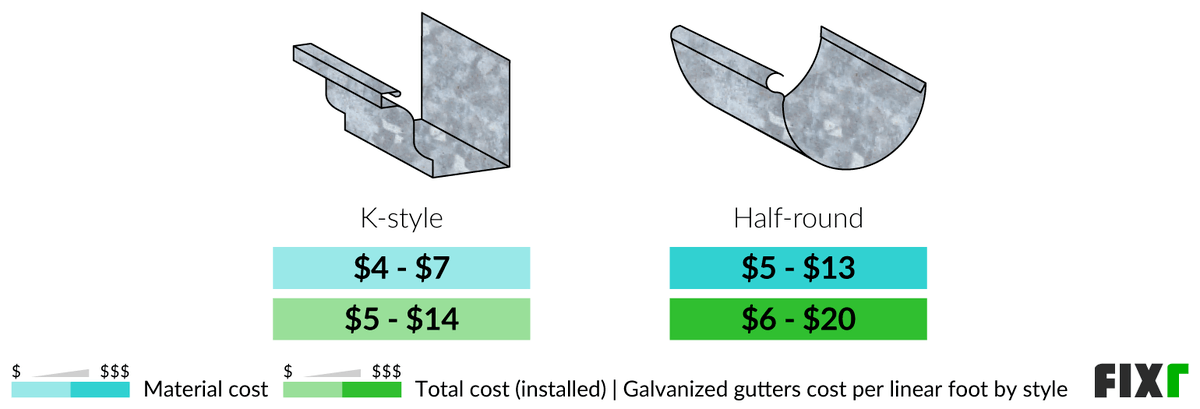

| Style | Cost per Linear Foot (Materials Only) | Cost per Linear Foot (Installed) |
| K-Style | $4 - $7 | $5 - $14 |
| Half-Round | $5 - $13 | $6 - $20 |
K-Style
K-style galvanized steel gutters cost $4 to $7 a linear foot for the material and $5 to $14 a linear foot installed. K-style gutters are some of the most common types. They get their name from their profile. When looked at side-on, the front resembles a capital letter K. K-style gutters are some of the most affordable. They are also slightly more decorative than half-round gutters. They do not come in as large a size as other gutter types or hold as much water as half-round gutters of the same size.
Half-Round
Galvanized half-round gutters cost $5 to $13 a linear foot for the material and $6 to $20 a linear foot installed. Galvanized half-round gutters resemble a tube that has been cut in half. This gutter type has a symmetrical U-shape style that used to be common in older historic homes. However, this style has also become a good match for modern-looking homes. The inside of a half-round gutter is smoother than others and has fewer creases so that water does not pool. This improves their durability and prevents corrosion. The smooth insides are more effective at washing debris out of the gutters. Half-round gutters require little maintenance compared to others because they do not leak as often. This style does not have a flat side, making the installation trickier.
Labor Cost to Install Galvanized Gutters
Galvanized steel gutters are installed by most gutter professionals, but a handyman may install some seamed gutters. Most professionals charge $1 to $7 per linear foot to install galvanized steel gutters, with seamless gutters having higher installation and material costs than seamed gutters. A standard installation of 150 linear feet of seamed galvanized steel gutters costs $600 to $1,950 in materials and $150 to $1,050 in labor, for a total cost of $750 to $3,000. Galvanized steel gutters are heavy, so most professionals inspect the fascia before installation to ensure it can withstand the weight of the new gutters. K-style gutters are generally nailed to the fascia, while a half-round gutter is installed with brackets. Seamed gutters are generally soldered on-site, while seamless gutters are extruded on-site and installed in long complete sections. The length can make them more difficult to install, increasing costs. Below are the average labor costs to install seamed and seamless gutters.


| Gutter Type | Average Labor Costs per Linear Foot | Average Costs per Linear Foot (Installed) |
| Seamed | $1 - $4 | $5 - $13 |
| Seamless | $4 - $7 | $12 - $20 |
Seamless Gutters and Downspouts Cost
Your downspouts funnel the water from your gutters from your home and foundation. They are typically installed with the gutters, and while they do not need to be made of the same material, they typically are for a cohesive look. Typical downspout installation costs between $300 and $600 for 4 downspouts. Combined with the cost of the gutters, this makes the typical installation of steel gutters and downspouts between $1,200 and $1,950. Some companies offer discounts on downspouts when installing gutters of the same material. Your roof’s shape and height affect the number of downspouts you need, their height, and final costs.
Galvanized Steel Gutters Replacement Cost
The old gutters must be removed when installing new gutters on an existing home. This is typically done if your gutters are old and leaking, but new gutters may be installed when you have a new roof or replace your fascia. Removing the old gutters costs $0.65 to $0.85 a linear foot. Costs for this depend on how difficult the old gutters are to remove and disposal costs. Most galvanized steel gutters are recyclable, cutting down on disposal costs. This makes the average cost to replace galvanized steel gutters between $5.65 and $20.85 a linear foot.

Pros and Cons
Knowing the pros and cons is helpful before deciding if galvanized steel gutters are the best option. Galvanized steel gutters have some clear advantages, including tough and durable materials that withstand the elements, corrosion, and extreme temperatures. They are less likely to leak than gutters made from other materials and can be painted different colors to suit your home. And they are easy to maintain during their long lifespan of 20 plus years. Galvanized steel is a versatile gutter material that can be installed with any shingle and has many attractive seamless options. However, galvanized steel is more expensive than many other gutter materials in material and labor costs. It can be tricky to install compared to other materials due to its weight. These gutters risk rusting and losing shape over time, particularly in high-salt areas, such as coastal regions.
Maintenance
One of the big advantages of galvanized gutters is that they do not require much maintenance. They are strong, durable, and difficult to damage with rain, ice, sleet, and snow. Seamless models are unlikely to suffer clogs or blockages, so they do not need to be cleaned often. They can also resist various extreme temperatures without losing shape.
Galvanized steel gutters still must be checked regularly for clogs and cleaned when needed. They should be repainted or sealed every few years to prevent rust. You can do some of this work yourself or hire a professional. Professional gutter cleaning costs $150 to $225, while gutter painting prices range from $200 to $600, depending on the amount of work.
Aluminum vs Galvanized Steel Gutters Cost
Many materials can be used for gutters. In addition to galvanized steel, another popular material is aluminum. Aluminum gutters are lighter than steel, making them easier to work with and install. They also come in more colors and styles than galvanized steel and are more common, so you can find them easily. Aluminum is better for coastal areas because it does not rust like steel.
However, aluminum is more costly than steel gutters. It is also more likely to dent because steel is stronger and more resistant to dents and dings, making steel better in hail-prone areas. Both types come in common colors and styles and can be seamed or seamless. Below are the average costs per linear foot to install both materials.

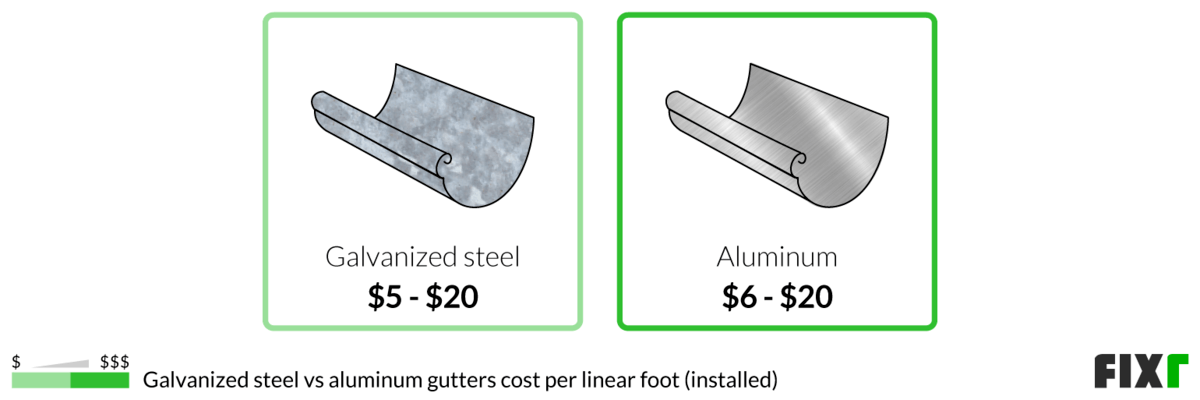
| Material | Average Costs per Linear Foot (Installed) |
| Galvanized Steel | $5 - $20 |
| Aluminum | $6 - $20 |
Galvanized Steel vs Stainless Steel Gutters Cost
Many steel types are on the market, including galvanized and stainless steel, which can be made into gutters. Galvanized steel is steel that has been coated and chemically bonded with zinc. This zinc coating makes the steel resistant to corrosion and rust and helps make the gutters stronger and long-lasting.
Stainless steel is a specific steel that contains roughly 10% to 30% chromium. It may also contain other materials like carbon, depending on the manufacturer. Stainless steel also resists rust and corrosion due to the chromium. Stainless steel gutters are relatively rare compared to other materials. Most steel gutters on the market are galvanized or galvalume - steel coated in aluminum.
Galvanized steel gutters are usually powder coated and come in many colors. Stainless gutters are generally left unpainted, so they have a modern appearance. Both materials have similar lifespans, but stainless gutters are typically more expensive than galvanized gutters. Below are the average costs per linear foot for each material installed.

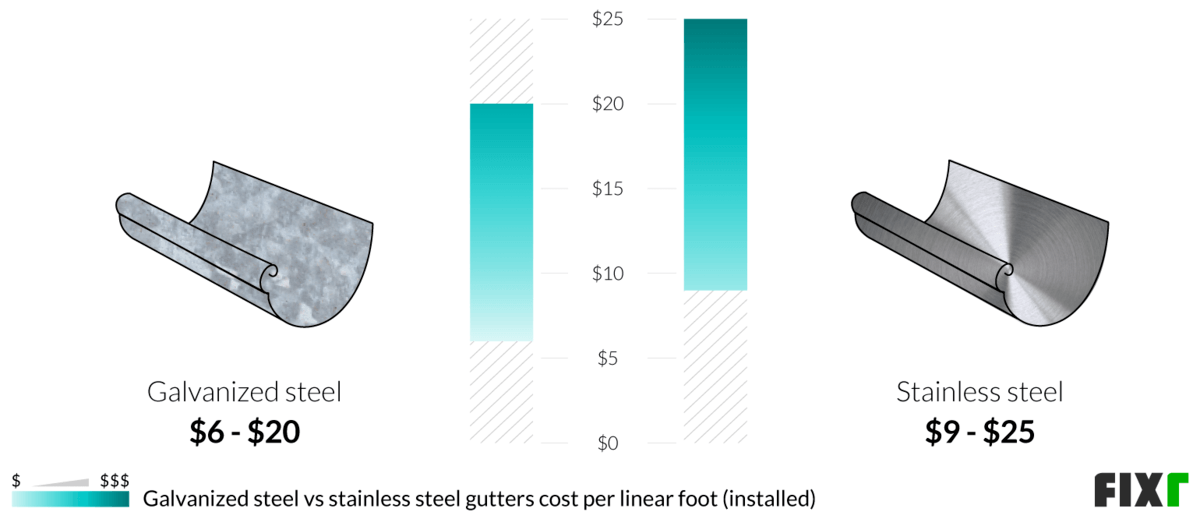
| Material | Average Costs per Linear Foot (Installed) |
| Galvanized Steel | $6 - $20 |
| Stainless Steel | $9 - $25 |
Enhancement and Improvement Costs
Gutter Guards
Gutter guards are barriers, preventing leaves and other large debris from falling into the gutters. Gutter guards eliminate the household task of cleaning the gutters and prevent cracks and clogs. You can buy different gutter guards for galvanized steel gutters, ranging from $2.60 to $18.50 per linear foot installed.
Downspout Screens
Downspout screens cost $2 to $3 per piece. Downspout screens are similar to gutter guards but placed over the downspouts, blocking debris from falling in the downspout and guiding the debris away from the gutters. The water drains without obstacles. They are usually fashioned from an aluminum material.
Heat Tape
Costs vary tremendously for heat tape, ranging from $10 to $25 per linear foot or $500 to $650 for most homes. Heat tape is another accessory you might consider for your gutters, especially if you live in a cold region. Ice can build up in your gutters when temperatures drop, causing many problems. Heat tape warms the gutters and prevents ice from forming.
Gutter Rain Chain
Rain chains direct water to landscaped beds, rain barrels, or other water features. They ensure water flows away from your home’s fountain. Rain chains are decorative alternatives to downspouts. They can be noisy as they catch and filter precipitation, but most people enjoy the peaceful sound. Gutter rain chains are inexpensive and cost $50 to $210 each installed.
Wire Mesh Screen
Gutter guards come in various types, but wire mesh screens stand out from the rest due to their excellent separating ability. Wire mesh screens keep leaves and small debris out while letting water through. Wire mesh screens have very fine openings, small enough to stop sand from going through. They cost between $0.80 and $1.25 a linear foot.
Additional Considerations and Costs
- Extreme climates. Galvanized steel is good for areas with extreme weather because it resists different temperatures and the elements. It withstands frost and snow well and is equally resistant to high temperatures.
- DIY. With some gutter materials, you install them yourself, but this is not recommended for galvanized steel gutters because of their weight. It is best to hire a professional, but this increases the costs compared to installing other gutters, such as vinyl and aluminum.
- Colors. There are not many color options for galvanized steel gutters. You usually only have a choice between white, brown, and classic steel gray colors. However, more options are becoming available, and some companies offer steel gutters in greens, blues, and reds. They can always be painted, so if you are willing to pay extra or do the painting yourself, you can decorate your steel gutters in any color.
- Gutter gauge. Gutters come in different thicknesses of metal, or gauges. The lower the number, the thicker the material and the higher the costs. Typical gauges for steel gutters range from 24 to 30.
- Time of year. You can replace gutters at any time of the year. However, your costs may be lower in the summer when times are slowest.
- Home value. Steel gutters do not add home value. However, functioning gutters help your home maintain its current value.
- New construction. New gutters are typically installed during new construction. Costs are similar to new gutter installation during a roof replacement or fascia replacement, without removal costs because there are no existing gutters to take off.
FAQs
- Will galvanized steel gutters rust?
This depends on your region and conditions and how thick the zinc coating is. They are more likely to rust in coastal areas than inland.
- Which is more expensive, galvanized steel or aluminum?
Aluminum is the most expensive at $6 to $20 per linear foot installed. Galvanized steel is slightly less at $5 to $20 per linear foot installed.
- Are galvanized steel gutters better than aluminum?
In some ways, galvanized steel gutters are better than aluminum gutters because they are stronger and more durable, resisting some damage caused by the elements. They are also fully compatible with all kinds of shingles, which is not always the case with aluminum gutters. However, aluminum gutters have advantages, such as they are cheaper, easier to install, and require less maintenance.
- How long do galvanized steel gutters last?
With proper care and regular maintenance, expect galvanized steel gutters to last a minimum of 20 years.
